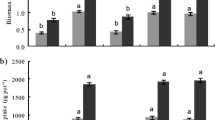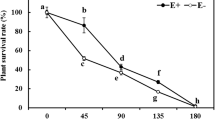Abstract
Neotyphodium coenophialum (Morgan-Jones and Gams) Glenn, Bacon and Hanlin, a fungal endophyte found primarily in shoots of tall fescue (Festuca arundinacea Shreb.), can modify rhizosphere activity in response to phosphorus (P) deficiency. In a controlled environment experiment, two cloned tall fescue genotypes (DN2 and DN4) free (E-) and infected (E+) with their naturally occurring endophyte strains were grown in nutrient solutions at low P (3.1 ppm) or high P (31 ppm) concentrations for 21 d. Endophyte infection increased root dry matter (DM) of DN4 by 21% but did not affect root DM of DN2. Under P deficiency, shoot and total DM were not affected by endophyte but relative growth rate was greater in E+ than E- plants. In high P nutrient solution, E+ plants produced 13% less (DN2) or 29% more (DN4) shoot DM than E- plants. Endophyte affected mineral concentrations in roots more than in shoots. Regardless of P concentration in nutrient solution, E+ DN2 accumulated more P, Ca, Zn and Cu but less K in roots than E- plants. When grown in high P nutrient solution, concentrations of Fe and B in roots of E+ DN2 plants were reduced compared with those of E- plants. Concentrations of P, Ca and Cu in roots of DN4 were less, but K was greater in E+ than E- plants. In shoots, E+ DN2 had greater concentrations of Fe and Cu than E- DN2, regardless of P concentration in nutrient solution. Genotype DN4 responded to endophyte infection by reducing B concentration in shoots. Nutrient uptake rates were affected by endophyte infection in plants grown in low P nutrient solution. A greater uptake rate of most nutrients and their transport to shoots was observed in DN2, but responses of DN4 were not consistent. Results suggest that endophyte may elicit different modes of tall fescue adaptation to P deficiency.
Similar content being viewed by others
References
Alloush G A and Sanders F E 1990 Responses of chickpea (Cicer arietinum L.) to iron stress measured using a continuous-flow-computer-controlled hydroponic system. In Plant Nutrition-Physiology and Applications. Ed. M L van Beusichem. pp 197–206. Kluwer Academic Publishers, Dordrecht, The Netherlands.
Amann C and Amberger A 1989 Phosphorus efficiency of buckwheat (Fagopyrum esculentum). Z. Pflanzenernaehr. Bodenk. 152, 181–189.
Arachevaleta M, Bacon C W, Hoveland C S and Radcliffe D E 1989 Effect of tall fescue endophyte on plant response to environmental stress. Agron. J. 81, 83–90.
Arechavaleta M, Bacon C W, Plattner R D, Hoveland C S and Radcliffe D E 1992 Accumulation of ergopeptide alkaloids in symbiotic tall fescue grown under deficits of soil water and nitrogen fertilizer. Appl. Environ. Microbiol. 58, 857–861.
Azevedo M D 1993 Studies on the fungal endophyte Acremonium coenophialum in tall fescue. Master Thesis. Oregon State University, OR.
Azevedo M D and Welty R E 1995 A study of the fungal endophyte Acremonium coenophialum in the roots of tall fescue seedlings. Mycologia 87, 289–297.
Azevedo M D, Welty R E, Creaig A M and Bartlett J 1993 Ergovaline distribution, total nitrogen and phosphorus content of two endophyte-infected tall fescue clones. In Proc. Second Int. Symposium on Acremonium/Grass Interactions. Eds. DE Hume, GCM Latch and HS Easton. pp 59–62. 4- 6 February 1993. AgResearch, Grassland Research Centre, Palmerston North, New Zealand.
Belesky D P and Fedders J M 1995 Tall fescue development in response toAcremonium coenophialum and soil acidity. Crop Sci. 35, 529–533.
Belesky D P and Hill N S 1997 Defoliation and leaf age influence on ergot alkaloids in tall fescue. Ann. Bot. 79, 259–264.
Belguendouz L, Fremont L and Linard A 1997 Resveratrol inhibits metal ion-dependent and independent peroxidation of porcine low-density lipoproteins. Biochem. Pharmacol. 53, 1347–1355.
Cheplick G P, Clay K and Marks S 1989 Interactions between infection by endophytic fungi and nutrient limitation in the grasses Lolium perenne and Festuca arundinacea. New Phytol. 111, 89–97.
Creek R and Wade G L 1982 Excretion of phenolic compounds from the roots ofFestuca arundinacea, Eragrostis curvula, and Lespedeza striata. Trans. Kentucky Acad. Sci. 46, 51–55.
De Battista J P, Bouton J H, Bacon C W and Siegel M R 1990 Rhizome and herbage production of endophyte removed tall fescue clones and populations. Agron. J. 82, 651–654.
Dennis S B, Allen V G, Saker K E, Fontenot J P, Ayad J Y M and Brown C P 1998 Influence of Neotyphodium coenophialum on copper concentration in tall fescue. J. Anim. Sci. 76, 2687–2693.
Graham R D 1984 Breeding for nutritional characteristics in cereals. In Advances in Plant Nutrition. Eds. PB Tinker and A Läuchli. Vol. 1, pp 57–102. Praeger, New York.
Heuwinkel H, Kirkby E A, Le Bot J and Marschner H 1992 Phosphorus deficiency enhances molybdenum uptake by tomato plants. J. Plant Nutr. 15, 549–568.
Hewitt E J 1966 Sand and water culture methods used in the study of plant nutrition. Eastern Press, London.
Hill N S 1994 Ecological relationships of Balansiae-infected graminoids. In Biotechnology of Endophytic Fungi of Grasses. Eds. CW Bacon and JF White, Jr. pp 59–71. CRC Press, Boca Raton, FL, USA.
Hinton D M and Bacon C W 1985 The distribution and ultrastructure of the endophyte of toxic tall fescue. Can. J. Bot. 63, 36–42.
Hunt R 1978 Plant growth analysis: Studies in biology 96. Edward Arnold, London, England.
Jungk A, Asher C J, Edwards D G and Meyer D 1990 Influence of phosphate status on phosphate uptake kinetics of maize (Zea mays) and soybean (Glycine max). Plant Soil 124, 175–182.
Khaliq A and Sanders F E 1997 Effects of phosphorus application and vesiculart arbuscular mycorrhizal inoculation on the growth and phosphorus nutrition of maize. J. Plant Nutr. 20, 1607–1616.
Kingston H M and Jassie L B 1988 Introduction to Microwave Sample Preparation. Am. Chem. Soc., Washington, D.C. 263 p.
Koeppe D E, Southwick L M and Bittell J E 1976 The relationship of tissue chlorogenic acid concentration and leaching of phenolics from sunflowers grown under varying phosphate nutrient conditions. Can. J. Bot. 54, 593–599.
Lapeyrie F F, Chilvers G A and Douglass P A 1984 Formation of metachromatic granules following phosphate uptake by mycelial hyphae of an ectomycorrhizal fungus. New Phytol. 98, 345–360.
Latch G C M and Christensen M J 1982 Ryegrass endophyte, incidence and control. New Zealand J. Agr. Res. 25, 443–448.
Le Bot J, Alloush G A, Kirkby E A and Sanders F E 1990 Mineral nutrition of chickpea plants supplied with NO3-or NH4- N. II. Ionic balance in relation to phosphorus stress. J. Plant Nutr. 13, 1591–1605.
Lewis G C, Bakken A K, Macduff J H and Raistrick N 1996 Effect of infection by the endophytic fungus Acremonium lolii on growth and nitrogen uptake by perennial ryegrass (Lolium perenne) in flowing solution culture. Ann. Appl. Biol. 129, 451–460.
Louis M St and Faeth S H 1997 The effect of endophytic fungi on the fitness of Arizona fescue (Festuca arizonica) under varying nitrogen levels. The Fourth Annual Undergraduate Research Poster Symposium, Arizona State University, Abstract 18.
Lyons P C, Plattner R D and Bacon CW 1986 Occurrence of peptide and clavine ergot alkaloids in tall fescue grass. Science 232, 487–489.
Lyons P C, Evans J J and Bacon C W 1990 Effect of the fungal endophyteAcremonium coenophialum on nitrogen accumulation and metabolism in tall fescue. Plant Physiol. 92, 726–732.
Malinowski D 1995 Rhizomatous ecotypes and symbiosis with endophytes as new possibilities of improvement in competitive ability of meadow fescue (Festuca pratensis Huds.). PhD Thesis. Diss ETH No. 11397. Swiss Federal Institute of Technology, Zürich.
Malinowski D P, Alloush G A and Belesky D P 1998a Evidence for chemical changes on the root surface of tall fescue in response to infection with the fungal endophyteNeotyphodium coenophialum. Plant Soil 205, 1–12.
Malinowski D P and Belesky D P 1999a Endophyte infection enhances the ability of tall fescue to utilize sparingly available phosphorus. J. Plant Nutr. 22, 835–853.
Malinowski D P and Belesky D P 1999b Infection with leaf fungal endophyteNeotyphodium coenophialum increases aluminum sequestration on root surfaces of tall fescue. J. Plant Nutr. 22, 1335–1349.
Malinowski D P, Belesky D P, Hill N S, Baligar V C and Fedders J M 1998b Influence of phosphorus on the growth and ergot alkaloid content of Neotyphodium coenophialum-infected tall fescue (Festuca arundinacea Schreb.). Plant Soil 198, 53–61.
Malinowski D P, Brauer D K and Belesky D P 1999 Neotyphodium coenophialum-endophyte affects root morphology of tall fescue grown under phosphorus deficiency. J. Agron. Crop Sci. 183, 53–60.
Moghimi A, Tate M E and Oades J M 1978 Characterization of rhizosphere products especially 2-ketogluconic acid. Soil Biol. Biochem. 10, 283–287.
Pfannmöller M, Eggestein St and Schöberlein W 1997 Occurrence of endophytes in European cultivars, seed lots and ecotypes of Festuca species. In Neotyphodium-Grass Interactions. Eds. CW Bacon and NS Hill. pp 77–81. Plenum Press, New York.
Powell R G, TePaske M R, Plattner R D, White J F and Clement S L 1994 Isolation of resveratrol from Festuca versuta and evidence for the widespread occurrence of this stilbene in the Poaceae. Phytochem. 35, 335–338.
Ravel C, Courty C, Coudret A and Charmet G 1997 Beneficial effects of Neotyphodium lolii on the growth and water status in perennial ryegrass cultivated under nitrogen deficiency or drought stress. Agronomie 17, 173–181.
Reniero F, Rudolph M, Angioni A, Bernreuther A, Cabras P and Mattivi F 1996 Identification of two stilbenoids from Vitis roots. Vitis 35, 125–127.
Roberts C A, Marek S M, Niblack T L and Karr A L 1992 Parasitic Meloidogyne and mutualistic Acremonium increase chitinase in tall fescue. J. Chem. Ecol. 18, 1107–1116.
Schulthess F M and Faeth S H 1998 Distribution, abundances and associations of the endophytic fungal community of Arizona fescue (Festuca arizonica). Mycologia 90, 569–578.
Siemann E H and Creasy L L 1992 Concentration of the phytoalexin resveratrol in wine. Am. J. Enol. Vitic. 43, 49–52.
Sleper D A, Garner G B, Nelson C J and Sebaugh J L 1980 Mineral concentration of tall fescue genotypes grown under controlled conditions. Agron. J. 72, 720–722.
Sylvia D M and Sinclair W A 1983 Phenolic compounds and resistance to fungal pathogens induced in primary roots of Douglas-fir seedlings by the ectomycorrhizal fungusLaccaria laccata. Phytopathology 73, 390–397.
West C P 1994 Physiology and drought tolerance of endophyteinfected grasses. In Biotechnology of Endophytic Fungi of Grasses. Eds. CW Bacon and JF White, Jr. pp 87–99. CRC Press, Boca Raton, FL, USA.
White J A and Brown M R 1979 Ultrastructure and x-ray analysis of phosphorus granules in a vesicular-arbuscular mycorrhizal fungus. Can. J. Bot. 57, 2812–2818.
Author information
Authors and Affiliations
Rights and permissions
About this article
Cite this article
Malinowski, D.P., Alloush, G.A. & Belesky, D.P. Leaf endophyte Neotyphodium coenophialum modifies mineral uptake in tall fescue. Plant and Soil 227, 115–126 (2000). https://doi.org/10.1023/A:1026518828237
Issue Date:
DOI: https://doi.org/10.1023/A:1026518828237




